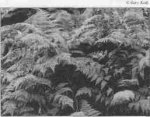EDITOR'S NOTEBOOK

Horse camps bring cash and controversy to the Shawnee
by Peggy Boyer Long
EDITOR'S NOTEBOOK

Horse camps bring cash and controversy to the Shawnee
by Peggy Boyer Long
Larry Flynn has been itching to saddle up Good Time Gal for another season on the trail. Shawnee, the national forest on Illinois' southern edge, is at the top of his list. "You just have so many things to see," the Pope County insurance agent tells writer Bill Lambrecht in this issue's cover story. "We've got some of the best riding there is."
Flynn's opinion is widely shared. This month, he and his Tennessee Walker can expect to meet up with hundreds of other horses on a ride through the Shawnee that was advertised nationally by the American Quarter Horse Associa- tion. And next month, some 2, 000 horses and their owners are expected to show up for a nine-day ride.
"No longer is the Shawnee's appeal to the equestrian set a secret," Lambrecht writes in the article that begins on page 16. "These days, Double Branch Hole, Jackson Hollow and the Shawnee's fetching waterfalls, deep pools and natural plunging escarpments ring with the year-round clomp of animals and commands to mount up."
This growing recreation source is generating new revenue in the most economically hard-pressed region of the state. But it's also sparking the biggest land-use tussle since the debates over logging.
Over the past couple of decades, conservationists have argued the Shawnee's 280,000 acres of public forest and wetlands encompass an ecological resource that is under threat. The latest controversy centers on the riding trails, and on the dozens of horse camps springing up at the margins of the Shawnee with their stables, showers and restaurants. But, as Lambrecht notes, the U.S. Forest Service, which oversees the national forests, is contemplating decisions likely to displease riders and conservationists alike.
It's a long-running story in the Shawnee, the only federal forest in Illinois and one of the smallest of 154 nationwide.
Spread across 10 southernmost counties, from the Ohio to the Mississippi rivers, the Shawnee is actually a patch-work. Its trees, wetlands and streams encompass about 150 state-listed endangered and threatened plants and animals, including Mead's milkweed, the Brown bat and the spring cavefish. But like other federal tracts, the Shawnee is a "working forest." It's been logged and mined. And it's a national playground.
Finding a balance between these uses and conservation won't be easy.
Bill Lambrecht has been writing about this debate over Illinois' natural resources for more than two decades. He began as a Statehouse reporter and now writes from Washington, D.C., for the St. Louis Post-Dispatch. He's been sharing this expertise with Illinois Issues since 1975.
Southern Illinois photographer Gary Kolb is appearing in our pages for the first time. His photographs of the Shawnee are part of an ongoing body of work aimed at documenting the forest.
Kolb teaches at Southern Illinois University at Carbondale. He has written two books on photographic technique and is the national chairman of the Society for Photographic Education. His work focuses on images of landscape.

|
"As controversy surrounding the uses, economic and recreational, of the Shawnee National Forest intensifies," he writes in a photographic essay begin- ning on page 22, "it is important to reflect upon the nature of this place, to bring a record of this landscape to public attention, and to record the forest as it now stands." |
4 June 1999 Illinois Issues